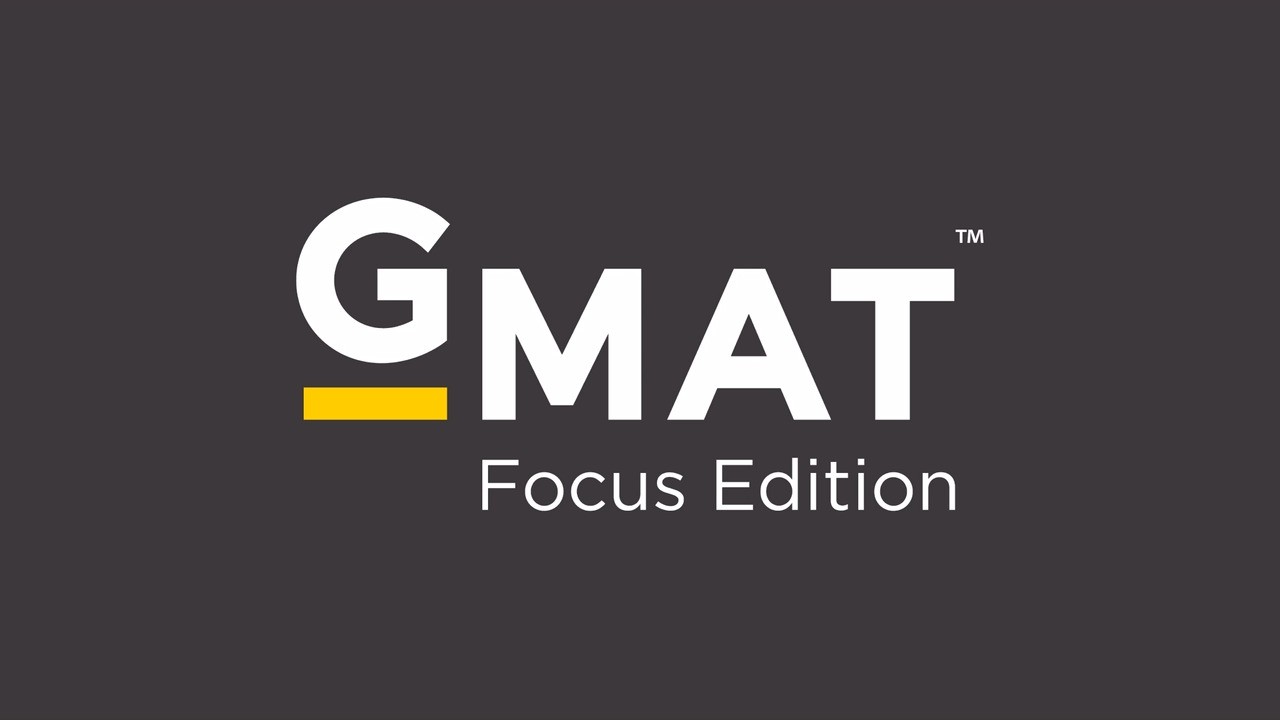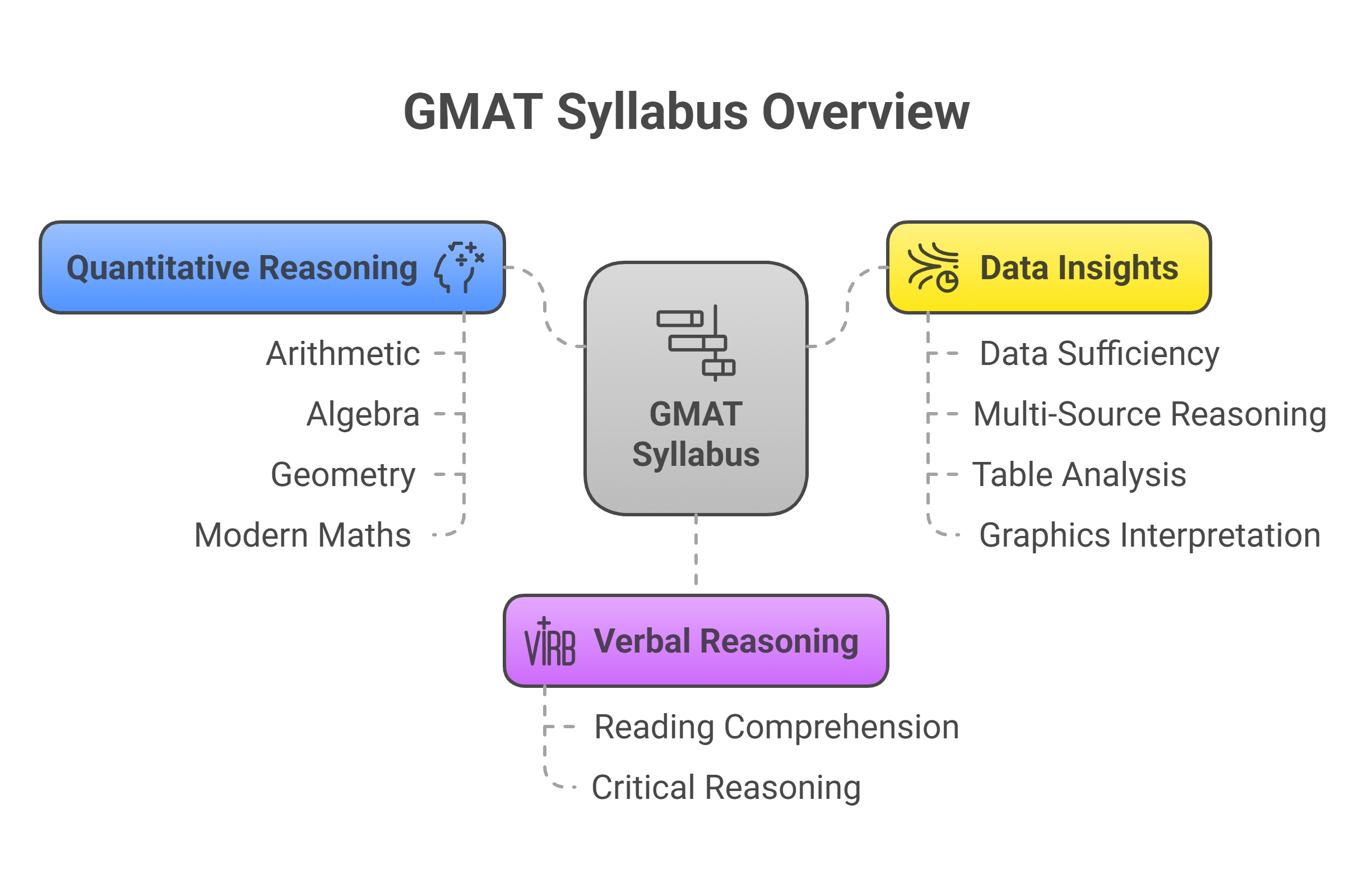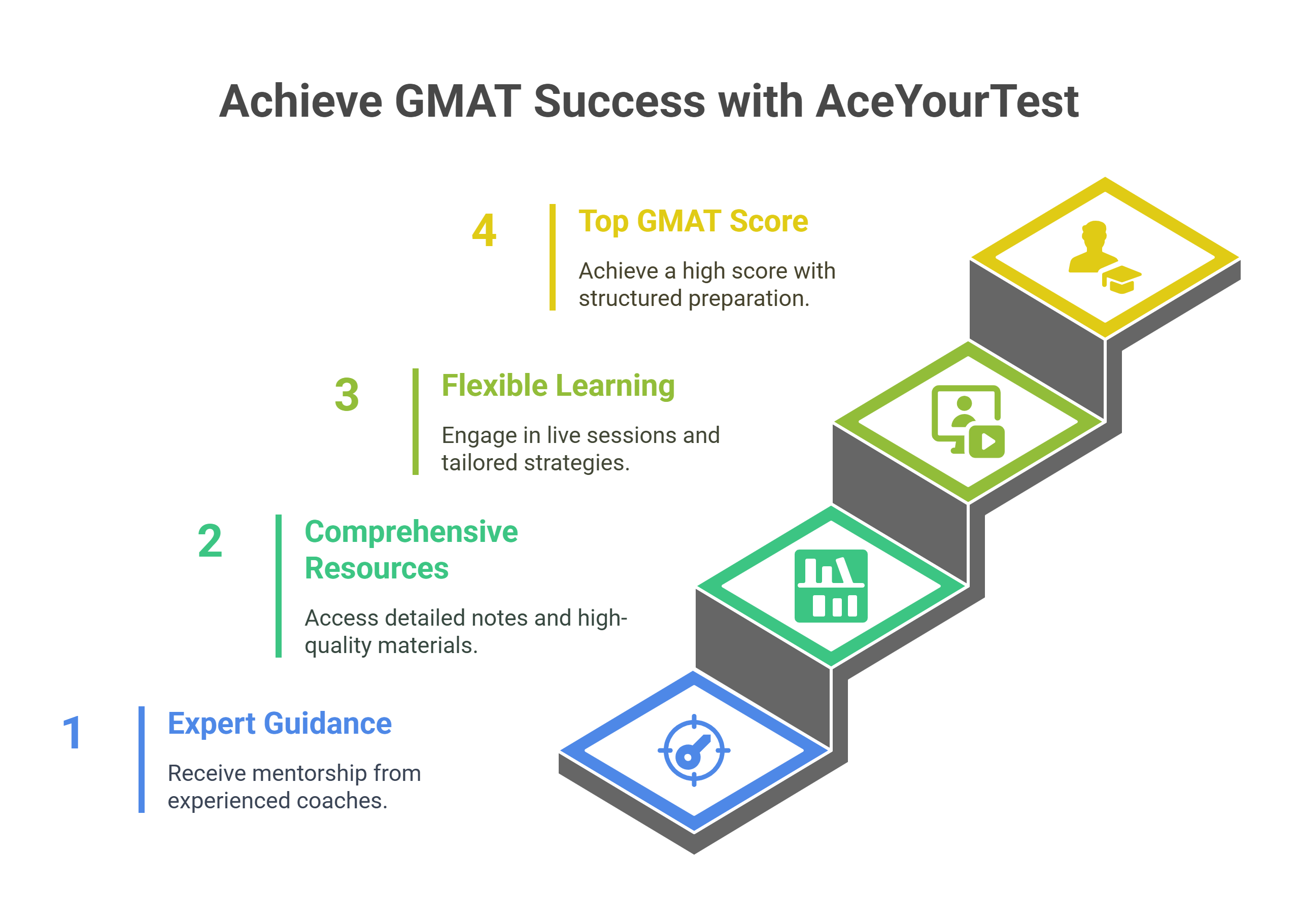
GMAT Exam 2025: A Complete Guide to the New Exam Structure
The Graduate Management Admission Test (GMAT) is a critical standardized exam for those seeking admission to top business schools worldwide. Accepted by over 2,300 institutions and more than 7,000 programs, the GMAT is often a key factor in the admissions process for MBA and other graduate management programs.
Recently, GMAT underwent significant changes with the introduction of the GMAT Focus Edition. Unlike the older version of the test, which had four sections, the updated syllabus now consists of three main sections – Quantitative Reasoning, Verbal Reasoning and Data Insights.
One of the most notable updates is the inclusion of the Data Insights (DI) section, which replaces the previous Sentence Correction (SC) and Analytical Writing Assessment (AWA) sections. The DI section merges elements from the former Integrated Reasoning (IR) and Data Sufficiency (DS) sections, reflecting the growing importance of data analysis in business decision-making.
In this blog post, we will explore the key components of the GMAT Exam 2025, what you can expect from each Syllabus, and how the changes impact your preparation strategy.
Highlights
GMAT Exam 2025: A Quick Overview
The GMAT exam has evolved over the years, with the most recent changes introduced in its 11th Edition, also known as the GMAT Focus Edition. It consists of three main sections—Quantitative Reasoning, Verbal Reasoning and Data Insights.

Here are a few key takeaways from the updated exam pattern:
- Time Allocation: Each section—Quantitative Reasoning, Verbal Reasoning, and Data Insights—has 45 minutes allocated.
- Flexible Exam Structure: Unlike traditional fixed or sequential question formats, the GMAT Focus Edition allows you to choose the section you want to start with.
- Changes to Syllabus: The new syllabus has eliminated the Sentence Correction (SC) section from the Verbal Reasoning part and removed the Analytical Writing Assessment (AWA) altogether, simplifying the exam structure.
- Break Time: Candidates are given a ten-minute break after completing the first or second section. This break is optional, meaning students can choose whether or not to take it.
- Review and Change Questions: If you have time left, you can review your answers and make changes to up to three questions per section. This feature provides you with the opportunity to correct mistakes or rethink your responses.
- No Negative Marking: The GMAT Focus Edition follows a scoring system where there is no negative marking. This means that even if you answer a question incorrectly, it won’t affect your score as a penalty.
Here’s a breakdown of the GMAT 2025 exam pattern:
| Conducted By | Graduate Management Admission Council (GMAC) |
|---|---|
Exam Sections | Three |
Duration for each Section | 45 minutes/section |
Scoring Scale | 205-805 |
Number of attempts | 5 times |
GMAT Fees (Test Centre) | $275 |
GMAT Fees (Online) | $300 |
GMAT Eligibility 2025
To appear for the GMAT Exam 2025, candidates must meet specific eligibility criteria set by the Graduate Management Admission Council (GMAC).

1. Age Requirement
- Candidates must be at least 18 years old to take the GMAT.
- If you are between 13 and 17 years old, you can still take the exam with parental or legal guardian consent.
2. Educational Qualification
- No specific educational qualification or degree is required to sit for the GMAT. However, most test-takers are typically those applying to graduate business programs, such as MBA programs, which may have their own academic prerequisites.
3. Number of Attempts
- You can take the GMAT up to 5 times within a 12-month period.
- There is a lifetime limit of 8 attempts.
4. Work Experience
- Work experience is not mandatory to take the GMAT. However, many MBA and business programs prefer candidates who have some level of professional work experience.
GMAT Focus Edition Syllabus 2025: An Overview
The GMAT Focus Edition follows a streamlined format, designed to evaluate your analytical, reasoning, and problem-solving abilities within a shorter time frame. The exam consists of three major sections: Quantitative Reasoning, Verbal Reasoning, and Data Insights.
With 64 questions to answer in 135 minutes, the new format is both concise and rigorous, ensuring that candidates are tested on a wide range of critical thinking and analytical skills.

The GMAT Focus Edition lasts 2 hours and 15 minutes, making it more efficient than the previous version. Key features of the new syllabus include three core sections.
- Quantitative Reasoning (QR): Tests problem-solving and mathematical reasoning skills, with a reduced emphasis on Geometry.
- Verbal Reasoning (VR): Focuses solely on Reading Comprehension and Critical Reasoning, as Sentence Correction has been removed.
- Data Insights (DI): A new section that integrates Integrated Reasoning (IR) and Data Sufficiency (DS), assessing data interpretation and analytical skills.
GMAT Focus Edition Syllabus 2025: Scoring System
The scoring range for the GMAT Focus Edition has also been updated. Instead of the previous 200–800 range, the new scale ranges from 205 to 805. This new scoring structure ensures a more refined assessment of candidates’ performance across all three sections.

GMAT Syllabus for Quantitative Reasoning
The Quantitative Reasoning section of the GMAT tests your ability to analyze mathematical data and make logical conclusions based on your reasoning skills. Spanning over 45 minutes, the section includes a variety of mathematical topics that require careful preparation and practice.
Topics in Quantitative Reasoning
- Arithmetic: Fractions, decimals, percentages, numbers (powers and roots), counting methods, ratio and proportion, sets, discrete probability.
- Algebra: Inequalities, absolute value, equations, functions, exponents.
- Geometry: Lines and angles, triangles, special right triangles, quadrilaterals, circles, polygons, 3D geometry (rectangular solids and cylinders), coordinate geometry.
- Modern Maths: Set theory, sequences and series, permutation and combination, probability.
Tips to Prepare for GMAT 2025 Exam Quants
Here are some strategies to help you tackle the Quantitative Reasoning section and boost your chances of success:
- Build a Strong Foundation: Begin by mastering the basics of mathematics. If you feel you need to strengthen your skills, consider starting with comprehensive guides like the Manhattan GMAT series. If your foundation is already solid, jump into solving GMAT-specific questions to hone your exam techniques.
- Organize Your Learning: Keep a dedicated notebook where you can write down key formulas, important concepts, and quick strategies. Make reviewing this material a regular part of your study routine.
- Consistent Practice: There’s no substitute for practice. Engage in regular problem-solving sessions to improve both your accuracy and speed. The more practice questions you tackle, the more familiar you will become with the types of problems you’ll face.
- Focus on Key Shortcuts: Enhance your calculation speed by memorizing essential math facts like squares up to 30 and cubes up to 20. Additionally, learning shortcuts for square and cube roots can save you precious time during the exam.
GMAT Syllabus for Verbal Reasoning
The Verbal Reasoning section of the GMAT assesses your ability to read, comprehend, and critically evaluate English text. This section, which lasts for 45 minutes, requires you to demonstrate strong analytical and reasoning skills.
Topics in Verbal Reasoning
- Reading Comprehension (RC): In this section, you’ll be given a passage and asked questions about its main idea, supporting details, inferences, context, style, and tone. It tests your ability to quickly grasp the meaning of complex written material.
- Critical Reasoning (CR): This section involves evaluating and constructing arguments. You’ll be asked to identify logical gaps, assumptions, and the strength or weakness of arguments, based on shorter passages. It requires you to assess the overall effectiveness of the presented argument and formulate or evaluate a course of action.
Tips to Prepare for GMAT 2025 Exam Verbal
Here are some strategies to help you perform well in the Verbal Reasoning section:
- Master the Reading Comprehension (RC) Question Types: Familiarize yourself with the various types of questions you’ll encounter in the RC section. Practice summarizing the main ideas of each paragraph as this will help you efficiently answer questions related to the passage’s overall meaning and specific details.
- Sharpen Your Critical Reasoning (CR) Skills: Gain proficiency in recognizing the different question types in the Critical Reasoning section. Practice identifying logical gaps, assumptions, strengths, and weaknesses in given arguments.
GMAT Syllabus for Data Insights
The Data Insights section is a new addition to the GMAT Focus Edition syllabus, designed to evaluate your proficiency in handling and analyzing data to draw conclusions, a skill highly relevant for business decision-making. Like the Quantitative and Verbal sections, the Data Insights section lasts for 45 minutes.
Topics in Data Insights
- Data Sufficiency: You will be given two data statements and asked to determine whether the information provided is sufficient to solve the problem. The goal is to assess how well you can evaluate the adequacy of given data.
- Multi-Source Reasoning: This type of question requires you to synthesize, compare, and interpret information from various sources, such as written passages, tables, graphs, diagrams, and other visual data representations.
- Table Analysis: In this section, you will analyze a table-like spreadsheet and determine statistics, ratios, proportions, or probabilities based on the data provided. This tests your ability to extract relevant information and perform calculations.
- Graphics Interpretation: Questions in this section will ask you to interpret data presented in graphical formats such as bar graphs, line graphs, scatterplots, and bubble charts. You will need to answer fill-in-the-blank questions based on the information conveyed by these visuals.
- Two-Part Analysis: These questions present two related problems, testing both your quantitative and verbal reasoning skills. You will need to solve both problems simultaneously, as they are interconnected.
Tips to Prepare for GMAT 2025 Exam Data Insights
Here are some strategies to help you perform well in the Data Insights section of the GMAT:
- Build Skills in Data Analysis: The Data Insights section requires you to analyze complex data from various sources. Focus on improving your ability to quickly interpret data and recognize patterns. Practice with different data sets, including tables, charts, and written material, to build this skill.
- Practice Regularly: Consistent practice is crucial for mastering the different question types in this section. Work on time management to ensure that you can analyze and solve problems within the 45-minute time frame.
- Familiarize Yourself with the Question Types: Each question type in Data Insights requires a slightly different approach. Spend time becoming comfortable with each type—whether it’s data sufficiency, multi-source reasoning, or graphics interpretation. The more familiar you are, the quicker you can identify the right strategy for solving each problem.
- Review and Analyze Mistakes: After practicing, take the time to review your errors thoroughly. Understand why certain answers were wrong and focus on improving the areas where you made mistakes.
What is a Good GMAT Score?
A good GMAT score varies depending on the business school and the level of competition, but there are general benchmarks that can help you assess your performance.
A GMAT score of 755 or higher places you in the 99.9th percentile, a highly impressive result that will undoubtedly enhance your candidacy for the most selective MBA programs. If you score above 750, you significantly improve your chances of admission to prestigious institutions like Harvard, Stanford, or Wharton, where competition is fierce.
On the other hand, average GMAT scores typically range from 535 to 665, which is the norm for applicants to schools that are reputable but less competitive than top-tier institutions. Schools, such as Toulouse Business School and the University of Edinburgh Business School generally accept scores within this range, provided other parts of the application are strong.
Boost Your GMAT Prep with AceYourTest
At Aceyourtest, we offer expert-led GMAT coaching with personalized study plans, 2,000+ practice questions, and interactive support. Our structured approach helps students achieve top scores.
Why Choose AceYourTest?

✔ Expert Guidance: Proven track record of mentoring 10,000+ students.
✔ Comprehensive Resources: Access to detailed notes and high-quality materials.
✔ Flexible Learning: Live sessions, doubt-solving groups, and tailored strategies.
Start Your GMAT Journey Today – Check the best GMAT Online Course with AceYourTest by Tarun Kaushik.
Conclusion: Key Takeaways
The GMAT Focus Edition is a significant update to the traditional GMAT exam, offering a more flexible and streamlined testing experience. The GMAT Focus Edition now consists of three sections—Quantitative Reasoning, Verbal Reasoning, and Data Insights, each lasting 45 minutes. This marks a departure from the previous four-section format.
Success on the GMAT comes down to consistent practice, effective time management, and a strong understanding of the syllabus. Whether it’s strengthening your quantitative skills, refining your verbal reasoning, or mastering data insights, comprehensive preparation will set you up for success.
Frequently Asked Questions (FAQs)
Is the GMAT Focus Edition easier than the previous GMAT structure?
The GMAT Focus Edition is more user-friendly, with a shorter duration and flexible section order. However, the difficulty level remains similar, with a new Data Insights section replacing some old components.
Will there be Sentence Correction on the new GMAT?
No, Sentence Correction has been removed. The Verbal section now consists only of Critical Reasoning and Reading Comprehension.
What does the Total Score include in the GMAT Focus Edition?
Unlike the previous GMAT, the Total Score now includes all three sections: Quantitative Reasoning, Verbal Reasoning, and Data Insights.